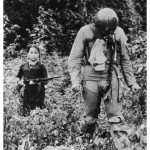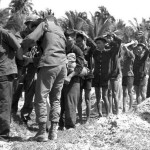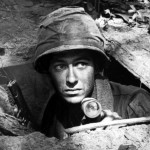
If at the height of the Vietnam War (1965-76) you had asked an American who their country was fighting in Vietnam, most would have said the Viet Cong. The Viet Cong was a network of communist agents and subversives, supplied and controlled by North Vietnam but active within South Vietnam. The origins of the Viet Cong begin with the Geneva Accords of 1954. Under the terms of the Accords, military personnel were ordered to return to their place of origin, either North or South Vietnam. Many Viet Minh soldiers and sympathisers, however, stayed in South Vietnam and remained ‘underground’, mostly in rural or remote areas. Their reasons for doing this are in dispute. Some historians suggest that indigenous communist groups in South Vietnam chose to remain there, rather than shift to the North. Others claim they did so under orders from Hanoi, which wanted to disrupt the development of the South and prepare for a future war. Whatever the reasons, by 1959 there were as many as 20 different communist cells scattered around South Vietnam. In total, these cells contained as many as 3,000 men.
The formation of an organised communist insurgency in South Vietnam was masterminded by Le Duan. A native of Vietnam’s southern provinces, Le Duan was active in communist groups in the Mekong region in the 1940s. By the mid-1950s, he was a high ranking member of the North Vietnamese government, occupying a seat in the Lao Dong Politburo. In 1956 Le Duan developed a plan, the ‘Road to the South’. In it he called for communists to rise up and gather support, overthrow South Vietnam’s leader Ngo Dinh Diem and expel foreign advisors and businessmen. Le Duan presented this plan to members of the Politburo but they did not support his call for a full-scale war. The Politburo considered North Vietnam’s domestic policies, such as economic and military reform, to be more pressing. It would be better, they said, to wait three years for attempting to facilitate a revolution in South Vietnam. Nevertheless the Politburo authorised communist insurgents in the South to begin a limited campaign of violence.

This began in mid-1957 with a few units carrying out acts of terrorism against foreigners, foreign sympathisers and government targets. South Vietnamese communists called this campaign of violence the “extermination of traitors”. In 1957 alone there were more than 150 assassinations attributed to communist subversives. In July, 17 people were killed by the Viet Minh underground in Chau Doc. A police chief and his family were murdered in September. The insurgents also carried out bombings of hotels and cafes in Saigon and other cities. Many of these locations were frequented by foreigners and several Americans were injured during these attacks. Newspapers in Saigon began referring to the insurgents as Viet Cong, a shortened form of Viet Nam Cong San (Vietnamese communists). The insurgents continued their violence between 1958 and 1959 while improving their organisation and command structures and obtaining the backing of Moscow.

Under international pressure to rein in this violence, the North Vietnamese government continually stressed that southern communists were acting independently, not under instruction from Hanoi. By mid-1959, however, the North was providing obvious support to the Viet Cong. The revolutionary movement in South Vietnam was formalised on December 20th 1960, with the formation of Mat Tran Dan Toc Giai Phong Mien Nam (the National Front for the Liberation of South Vietnam). Westerners came to know it as the National Liberation Front (NLF). Shortly after its formation, the NLF issued a ten-point program that called on the Vietnamese people to “overthrow the camouflaged colonial regime of the American imperialists and the dictatorial power of Ngo Dinh Diem”. Membership of the NLF grew rapidly, filled both by southern sympathisers and thousands of communists who streamed down from the North. The NLF also adopted its own anthem called Giai Phong Mien Nam (Liberate the South):
“To liberate the South we decided to advance.
To defeat the American Empire and destroy the country sellers.
Oh bones have broken and blood has fallen, the hatred is rising high.
Our country has been separated for so long.
Here the sacred Cuu Long river.
Here glorious Truong Son Mountains
Are urging us to advance to kill the enemy,
Arm by arm under a common flag.”
By 1961 the NLF’s internal organisation had evolved further and resembled the structure of the Lao Dong. Major decisions were made by a Presidium (in effect, a mini Politburo) and implemented by a Secretariat. On the ground, the NLF adopted its own “shadow government”, which operated across 20 regions and was commanded by a party official. Within each region, there were several districts and villages, overseen by one or more NLF cadres. The role of these cadres went beyond military and guerrilla operations. The NLF was also a political movement that worked to attract and build popular support. NLF teachings stressed two important concepts: dan tranh (‘struggle’) and giai phong (‘liberation’). Its cadres circulated these ideas by organising political education forums, youth groups and women’s groups. The NLF also disseminated information and propaganda that praised communist ideas and values, as well as communist land reforms in the North. Cadres also informed people about the crimes and exploitations of South Vietnamese leader Ngo Dinh Diem and his followers.
The NLF’s military arm was called the Quan Doi Giai Phong (Liberation Army). South Vietnamese and Westerners knew it as the Viet Cong. Its members were given extensive political and historical training, including sessions about the failure of the Geneva Accords, American double standards and the excesses of the Diem regime. For obvious reasons, most NLF operations could not be conducted in the open. In most parts of South Vietnam, the NLF remained an underground organisation; its movements and activities were often described as “ghostly”. There was no NLF uniform or insignia, so most Viet Cong were indistinguishable from ordinary South Vietnamese. There was also no official NLF headquarters or even a particular area where NLF officials could be found. Presidium members held their meetings in remote locations, rarely meeting in the same place twice. Their decisions were passed along the chain of command either by word of mouth or on scrawled notes written in code.
“The reasons a man or woman joined the VC are as varied and complex as individuals themselves. The most common was simply disillusionment with the government in Saigon, and acceptance of the constant barrage of NLF propaganda. Often the only contact villagers had with the government was through heavy-handed tax collectors and ARVN soldiers. Saigon was a place they had only heard of. The peasant’s real loyalties were to his or her family and village. Beyond that, district, province and national government had no meaning… After 1965, ARVN and US troops were to blame for many turning to the VC.”
Gordon L. Rottman
Thousands of South Vietnamese, marginalised and dispossessed by the corruption and brutality of the Diem regime, enlisted to fight with the NLF. Those unable to fight – including women, children and the elderly – gave support in other ways, promising to provide food, safety and information about enemy troop movements. Buddhist monks, former members of religious sects like the Cao Dai and Hoa Hao, displaced peasants and urban workers could be found in NLF ranks. Support did not only flow one way, however. The NLF’s bombings, sabotage and assassinations also generated considerable opposition. These attacks, though aimed at foreign or South Vietnamese government targets, often killed innocent civilians, destroyed private property and disrupted business. As a consequence, there were many South Vietnamese who supported neither the Diem government or the NLF.

By 1960, the NLF had grown and evolved into a sophisticated communist insurgency. With the approval of Hanoi, the NLF increased its terrorist activities in the South. In October 1961 there were 150 NLF bombings and attacks, triple the number of the previous month. This escalation prompted US president John F. Kennedy to increase the number of American military advisors in South Vietnam, with several thousand arriving over the next six months. One of the most successful Viet Cong operations occurred in January 1963 when around 1,500 South Vietnamese (ARVN) soldiers, along with American advisors, tracked down 300 Viet Cong near Ap Bac in the Mekong delta. As the ARVN soldiers approached the enemy across rice fields, the Viet Cong were able to inflict heavy casualties from concealed positions. The ARVN had the advantage of American helicopters, however even these proved ineffective at locating and eliminating the enemy. Around 200 ARVN troops were shot, almost half of them fatally, while three US advisors were also killed. In contrast, the Viet Cong lost only 18 men. The tactics they employed at Ap Bac – stealth, concealment, patience, discipline and teamwork – had withstood the most modern weaponry in Vietnam. It was not the last time these tactics would prove successful.

After the American military escalation in 1965, eradication of the Viet Cong became the number one objective for the US military. The Viet Cong were both featured and demonised in the American press. They were painted as communist revolutionaries and heartless terrorists, responsible for every act of carnage in South Vietnam. American military personnel serving in Vietnam knew them as “VC”, “Victor Charlie”, “Charlie” or “Chuck”. The attitude of most American soldiers towards the Viet Cong evolved into a combination of hatred, fear and begrudging admiration. The Viet Cong were cursed and condemned for not following the Western conventions of war. They were labelled cowards for refusing to fight in open battle. Instead, the Viet Cong relied on elements of speed and surprise. Ambushes, lightning raids, sniping, tunnel warfare, land mines and booby traps became their preferred tactic. Viet Cong soldiers were subversive, evasive and crafty, hiding among civilian populations, taking shelter in thick jungle, moving only in the dead of night. As the Vietnam War unfolded, the world’s strongest military power found itself at war with an enemy that could scarcely be found.

1. The Viet Cong was the military arm of the National Liberation Front (NLF), an underground communist insurgency formed in December 1960 and active in South Vietnam.
2. The seeds of the NLF were several thousand communists who defied the terms of the Geneva Accord (1954) and remained underground in South Vietnam.
3. As support for the NLF grew it adopted organisation and command structures similar to those of the Lao Dong, as well its own a military arm, the Viet Cong.
4. The NLF and Viet Cong were shadowy organisations that blended into rural life but remained politically and militarily active, recruiting and disseminating propaganda.
5. Viet Cong bombings and operations increased from late 1961. Using guerrilla methods they targeted foreign and government personnel, buildings and facilities.

The program of the National Liberation Front or Viet Cong (1962)
A CIA report on Viet Cong weaknesses and vulnerabilities (July 1965)
US Dept of Defence pamphlet: Know Your Enemy: the Viet Cong (March 1966)
A Viet Cong guerrilla on the Tet Offensive (1968)
A Viet Cong soldier on their approach to tactics and warfare (1985)
© Alpha History 2018. Content on this page may not be republished or distributed without permission. For more information please refer to our Terms of Use.
This page was written by Jennifer Llewellyn, Jim Southey and Steve Thompson. To reference this page, use the following citation:
J. Llewellyn et al, “The Viet Cong”, Alpha History, accessed [today’s date], https://alphahistory.com/vietnamwar/viet-cong/.
